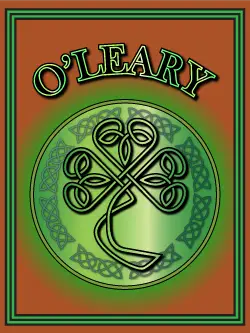O’Leary is a popular surname name that developed in South West Ireland and dates back 1,500 years.
It comes from the old Gaelic name O’Laoghaire. The ‘O’ prefix means ‘grandson of’ or ‘descendent of’. Laoghaire is made up of two Gaelic words – ‘laogh’ which means ‘calf’ and ‘aire’ which means ‘keeper’.
So the name means ‘descendant of the keeper of the calves’.
They can trace their ancestry back to Lugaid Mac Con, who was High King of Ireland in the late 2nd century AD. Mac Con belonged to the Dáirine, who ruled Munster during that time, and was also an ancestor to the O’Driscoll, Hennessey, Flynn and Coffey families in Co Cork.
King Laoghaire mac Néill
Another ancestor is the 5th century King Laoghaire mac Néill. King Laoghaire is said to be a son of Niall of the Nine Hostages and was the man the O’Learys take their name from. The seaside town of Dún Laoghaire in Co Dublin is named after him. The word ‘dún’ meant ‘fort’ and the king used the town as his sea base to launch raids on Britain and Europe.
There are several variations of the O’Leary name including Lary, Laury, Learey, Leary, O’Laohaire, O’Laoghaire and O’Laoire.
The motto on the O’Leary family crest reads ‘Laidir isé lear Righ’ which translates as ‘Strong is the King of the Sea’.
Lords of Rosscarberry
The O’Learys were lords of Ros Ó gCairbre, the town now called Rosscarberry, in Co Cork. They remained an important family for centuries. By the 12th century they were still recognised wardens of the school of Ross, a seat of higher learning. They were also wardens of St Fachtna’s monastery.
The Dáirine were later known as the Corcu Loígde. They began to lose their power in the 7th century AD as the Eóganachta began to emerge.
By the 13th century the remaining Corcu Loígde, including many O’Learys were forced to move north from the coastal area of Rosscarberry to what is now the town of Macroom.
Decline in power
By the 16th century, many O’Learys still had titles and wealth but now it was the MacCarthys who had become the most powerful family in the region. The MacCarthys gave the ‘white wand’ to both the O’Learys and the O’Mahoneys. Symbolically, the white wand meant that a recipient could rule as a king or lord over a territory.
During this period the O’Learys built several castles in Co Cork including Carrignacurra Castle. Carrignacurra is the only O’Leary castle still standing today.
Not long after the castle had been built, the O’Learys lost it to the O’Sullivans. It was later taken by the MacCarthys.
Eventually, the O’Learys lost their land and power as a result of both the Nine Year War (1594-1603) against the English, and later the Cromwellian confiscations. The Cromwellian confiscations were imposed on any Irish Catholics who took part in the 1641 Rebellion against English rule.

Famous O’Learys
Denis Leary is an American actor and comedian. He has appeared in several hit movies including The Amazing Spiderman, Ice Age, A Bug’s Life and Natural Born Killers.
David O’Leary is an Irish former soccer player. He helped Arsenal win two league titles and many more trophies. He played for Ireland in the 1990 World Cup and scored the winning penalty in a shoot-out against Romania to send them to the Quarter Finals – Ireland’s greatest ever soccer achievement.
Michael O’Leary is an Irish businessman and one of Ireland’s wealthiest men. He is the Chief Executive of budget airline Ryanair. He is known for his eccentric and (usually) tongue-in-cheek cost cutting ideas that he uses to promote his firm.
Dermot O’Leary is a British/Irish TV and radio presenter. He has presented some of the most watched shows in the UK such as Big Brother and the X Factor.
John O’Leary is an American actor. He has appeared in hit series such as 24, CSI: Miami, The X-Files and Home Improvement. He also appeared in movies such as Candyman: Farewell to the Flesh and Terminator 3: Rise of the Machines.
